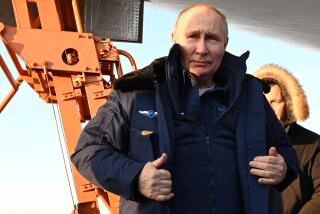Russians Show How B-29 Was Copied in 1940s
- Share via
WASHINGTON — Historians from the former Cold War adversaries revealed Thursday how the Soviet Union in the 1940s copied piece by piece the American B-29, the only plane capable of transporting nuclear weapons at the time.
The event to unveil the revelations was itself a striking testament to how times have changed since the Cold War.
U.S. and Russian historians gathered at the Russian Embassy to describe how they exchanged information to reveal how the former Soviet Union copied one of the most prized U.S. military aircraft of the time.
The Russian historians brought an original sketchbook of fine pencil drawings of circles, lines and measurements of the B-29 Superfortress.
U.S. intelligence officers were startled when they saw the Soviet Tu-4 at an air show in August 1947 because the plane appeared to be a replica of the B-29, three of which had been confiscated by the Soviets, said Von Hardesty, Smithsonian National Air and Space Museum curator.
What was suspected turned out to be true. How the Soviets copied the B-29 is described in “Made in the USSR,” written by Hardesty in the March issue of the Smithsonian’s Air and Space magazine.
The article resulted from a cooperative effort with the Russian Academy of Sciences and the Tupolev Museum, named after the lead designer of the Tu-4.
The Tu-4 in subsequent years turned into an intercontinental threat to the United States because it could deliver a nuclear bomb.
The confiscations occurred in 1944, when the bombers made emergency landings at Vladivostok on Russia’s far eastern coast. That same year Soviet leader Joseph Stalin directed a strategic bomber be built.
In 1945 Soviet pilots conducted test flights of the B-29, and the first Tu-4 came off the assembly line in early 1947.
“The B-29 landings gave the Soviets an unusual opportunity and one they fully exploited, because at the end of World War II, the Soviet Union had . . . 32 operational four-engine bombers,” Hardesty said.
More to Read
Sign up for Essential California
The most important California stories and recommendations in your inbox every morning.
You may occasionally receive promotional content from the Los Angeles Times.








